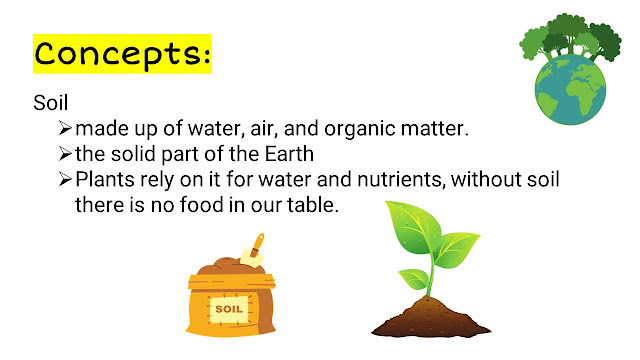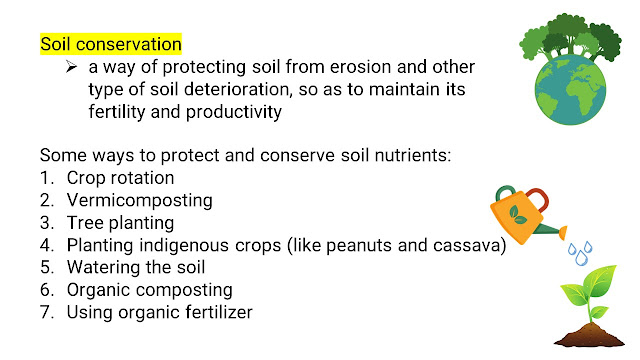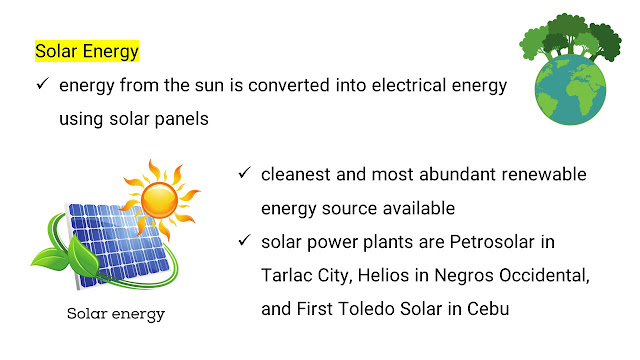Earth’s Resources
 |
| What is a Watershed? - North and South Rivers Watershed Association (nsrwa.org) |
Simple video animation (watch the short video to answer the following Guide Questions):
Guide Questions:
1. What are the different Earth’s resources that we need to conserve?
2. Give two energy resources mentioned in the short video.
I. Conservation of Water Resources
Concepts:
Watershed
– an area of land on a slope that drains its water into a stream and its tributaries
Tributaries
– small streams that supply water to the mainstream, such as a river, lake, or bay
Watershed boundary
– the highest point of the area
- When it rains, water runs downhill forming rivers, streams, and lakes until it reaches the ocean.
- Not all rain flows out in this way. Some seep into the ground as groundwater, and some become runoff, carrying soil, pollutants, and other materials into the waterbody.
- Excess runoff can cause flood and river or stream erosion.
Watershed
- serves as a habitat for wildlife
- covers all the lands on Earth
- comes in all shapes and sizes
- maybe a combination of forests, grasslands, marshes, ponds, and other ecosystems
- Of all water on Earth, only 3% is freshwater, and 97% is saltwater.
- Of this 3%, more than half is frozen as snow and ice, and a large amount is stored as groundwater.
- There is only 0.3% freshwater that supplies all the inhabitants on the Earth.
Some Ways of Conserving Water Resources
II. Conservation of Soil Resources
Crop rotation
– a practice of planting different crops each harvest to reduce the loss of nutrients from the soil
Vermicomposting
– a process where earthworms feed and burrow through the soil, and their castings (wastes) serve as fertilizer.
Tree planting
– helps cover and hold the soil together, protecting it from erosion
Planting indigenous crops (like peanuts and cassava)
– helps enhance soil fertility and reduces the need for commercial fertilizers
Watering the soil
– nourishes the plants and moistens the soil which prevents erosion due to wind activity
Organic composting
– helps the soil absorb and retain its nutrients and moisture
Using organic fertilizer
– nurtures the soil with organic matter and reduces dependency on chemical products
III. Energy Resources
Trivia!Fossil fuels were formed from plants and animals that lived millions of years ago and are buried deep in the earth. Examples are coal, petroleum (crude oil), and natural gas. We only have coal and natural gas in the country.
Trivia!Carbon dioxide (CO2) is naturally present in the air in small amounts. Much of this is produced by burning fossil fuels. Studies show that an increase in carbon dioxide in the atmosphere increases atmospheric temperature resulting in global warming.
III. Conserving and Protecting Natural Resources
Conserving and Protecting Natural Resources
- Natural resources are all connected in a way.
- We tap into their supply to survive and also to function properly.
- Therefore, if one is taken away, it has a great effect on other resources.
- When water is eliminated from an area, the vegetation, soil, animals, and even the air in that area will be affected negatively.
- All resources used by humans are not in endless supply.
- Lack of environmental awareness, human greed, and carelessness are threatening the natural resources to their depletion and extinction.
- To conserve natural resources is to protect or use them wisely without wasting them or using them up completely.
- Sustainability of natural resources means conserving them to make them last.
- Therefore, each of us should take part to make these resources available for future generations.
Credits:
- Science7_Q4_M2A-M2D_v2.pdf
- www.canva.com
- https://www.nsrwa.org/what-we-care-about/what-is-a-watershed/
- https://eschooltoday.com/learn/what-is-a-natural-resource/
Please Subscribe for more educational videos - E-learning Virtual Assistant
**LET'S CONNECT**
Facebook Page: E-learning Virtual Assistant
Instagram: @your.elearningva
HeyLink: E-learning Virtual Assistant
THANK YOU SO MUCH! 😍




















Comments
Post a Comment